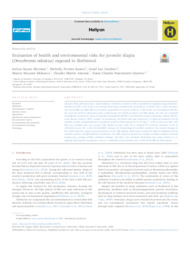Evaluation of health and environmental risks for juvenile tilapia (Oreochromis niloticus) exposed to florfenicol.
Evaluation of health and environmental risks for juvenile tilapia (Oreochromis niloticus) exposed to florfenicol.
Autoria: SHIROMA, L. S.; SOARES, M. P.; CARDOSO, I. L.; ISHIKAWA, M. M.; JONSSON, C. M.; QUEIROZ, S. C. do N. de
Resumo: Abstract: Intensive fish cultivation has a high incidence of infection, which is often controlled by administering antibiotics. Florfenicol (FF) is one of the two antimicrobial drugs permitted for aquaculture in Brazil. Due to their intensive use, potentially harmful effects on aquatic organisms are of great concern. In this sense, we investigated whether the presence of FF in cultivation water could change the health parameters of Nile tilapia. For this, we evaluated hemoglobin, hematocrit, mean corpuscular hemoglobin (MCHC) concentration, mean corpuscular volume (MCV), total plasma protein (TPP), number of circulating red blood cells and leukocytes, as lipid peroxidation levels, catalase activity and glutathione S-transferase activity of fish exposed to 11.72 mg L-1 of FF in water for 48 h. The fish were divided into two groups: Nile tilapia in water with FF or without FF (control). Exposure to FF in cultivation water for a short period didn\t change the hematological variables analyzed, but caused changes in liver ROS (Reactive oxygen species) markers of the Nile tilapia, which was revealed by lipid peroxidation levels, catalase activity, and glutathione S-transferase. The 48h exposure period was enough to induce oxidative stress in hepatocytes, causing cellular oxidative damage. Therefore, the antibiotic florfenicol may cause toxicity to organisms and aquatic ecosystems, even at a sublethal concentrations near 1/100 LC50-48h for fish species.
Ano de publicação: 2020
Tipo de publicação: Artigo de periódico
Unidade: Embrapa Meio Ambiente
Observações
1 - Por padrão são exibidas publicações dos últimos 20 anos. Para encontrar publicações mais antigas, configure o filtro ano de publicação, colocando o ano a partir do qual você deseja encontrar publicações. O filtro está na coluna da esquerda na busca acima.
2 - Para ler algumas publicações da Embrapa (apenas as que estão em formato ePub), é necessário ter, no celular ou computador, um desses softwares gratuitos. Sistemas Android: Google Play Livros; IOS: iBooks; Windows e Linux: software Calibre.
Acesse outras publicações
Acesse a Base de Dados da Pesquisa Agropecuária (BDPA) para consultar o acervo completo das bibliotecas da Embrapa.

